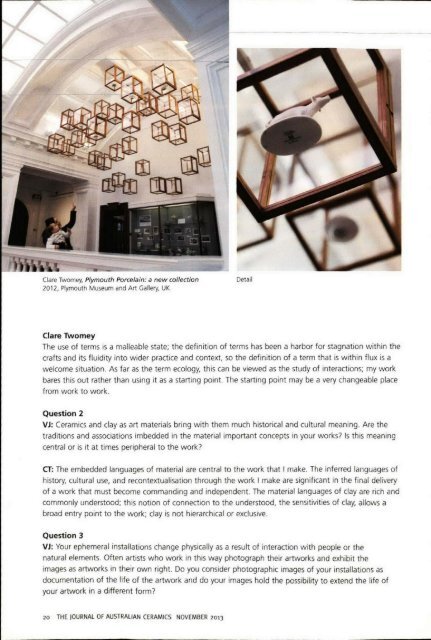The Journal of Australian Ceramics Vol 52 No 3 November 2013
Create successful ePaper yourself
Turn your PDF publications into a flip-book with our unique Google optimized e-Paper software.
Clare Twomey, Plymouth Porcelain: a new collection<br />
2012, Plymouth Museum and Art Gallery, UK<br />
Detail<br />
Clare Twomey<br />
<strong>The</strong> use <strong>of</strong> terms is a malleable state; the definition <strong>of</strong> terms has been a harbor for stagnation within the<br />
crafts and its fluidity into wider practice and context, so the definition <strong>of</strong> a term that is within flux is a<br />
welcome situation. As far as the term ecology, this can be viewed as the study <strong>of</strong> interactions; my work<br />
bares this out rather than using it as a starting point. <strong>The</strong> starting point may be a very changeable place<br />
from work to work.<br />
Question 2<br />
VJ: <strong>Ceramics</strong> and clay as art materials bring with them much historical and cultural meaning. Are the<br />
traditions and associations imbedded in the material important concepts in your works? Is this meaning<br />
central or is it at times peripheral to the work?<br />
CT: <strong>The</strong> embedded languages <strong>of</strong> material are central to the work that I make. <strong>The</strong> inferred languages <strong>of</strong><br />
history, cultural use, and recontextualisation through the work I make are significant in the final delivery<br />
<strong>of</strong> a work that must become commanding and independent. <strong>The</strong> material languages <strong>of</strong> Clay are rich and<br />
commonly understood; this notion <strong>of</strong> connection to the understood, the sensitivities <strong>of</strong> clay, allows a<br />
broad entry point to the work; clay is not hierarchical or exclusive.<br />
Question 3<br />
VJ: Your ephemeral installations change physically as a result <strong>of</strong> interaction with people or the<br />
natural elements. Often artists who work in this way photograph their artworks and exhibit the<br />
images as artworks in their own right. Do you consider photographic images <strong>of</strong> your installations as<br />
documentation <strong>of</strong> the life <strong>of</strong> the artwork and do your images hold the possibility to extend the life <strong>of</strong><br />
your artwork in a different form?<br />
20 THE JOURNAL OF AUSTRALIAN CERAMICS NOVEMBER 201)

















